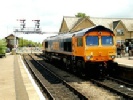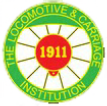Archive Section




© John Hayward
Date: Thursday 19th April 2012
Our group was met at New Cross Gate station at llam. We entered a gate at the north end of platform 2 and then proceeded along a walkway next to London Overground’s East London Line (ELL) tracks and adjacent sidings. At the far end of this walkway was a security gate which was opened for us. New Cross Gate depot, which opened in March 2010. is the main depot for the East London Line.
The ELL is operated by the London Overground Rail Operations Ltd (LOROL), which is contracted to operate the London Overground (LO) train service on the National Rail network, under the franchise control of Transport for London. The company is a 50:50 joint venture between the Hong Kong metro rail operator (MTR Corporation) and the rail operator Arriva LK Trains. They work together with a number of companies to deliver and maintain a new high quality railway and rolling stock. and to operate the new railway successfully. The responsibilities are as follows:
- LOROL e Train Operation, Station Management & Traincrews;
- Network Rail -
Signalling, Route Control & Traction Current Control; - Bombardier -
Servicing of ELL & NLL Class 378 EMU's; - London Underground -
Station Management at Whitechapel & Canada Water; - (5) Carillion -
Infrastructure Maintenance Contractor;
After operating for nearly 75 years as part of the Underground network, the ELL closed on 22nd December 2007' for an extensive refurbishment and expansion project, reopening as Phase 1 oft he ELL extension on23rd May 2101. This extended the former Underground line northwards from Whitechapel to Dalston Junction using 2.25 miles of new trackbed. A ffurther 1.3mile extension from Dalston Junction to Highbury & Islington was opened on 28th February 2011.
Phase 2 of the ELL. which will link the line to the South London Line (SLL) with a terminus at Clapham Junction, is due to be completed in December 2012.
Getting back to our visit, New Cross Gate depot has been built and equipped to a very high standard. It was clear from our visit that both the depot and trains are being maintained that way. The depot is home to a fleet of 24 x -
We were taken to the Operational Building Complex, containing the drivers’ signing on and off point (for over 100 staff), general staff facilities, offices and the control room. We were invited into a meeting room where the depot manager gave a short introduction to the site as well as handing out visitor information packs and giving safety instructions.
We were told that thought is now being given to adding an extra coach to the existing four car Class 378 EMUs to make them into five car EMUs. It seems that the process of expanding the 3785 to include a fifth car has been accepted as a "must do”. By Howard Smith, the Chief Operating Officer for TfL London Rail. This will take place in 2013/14 and will no doubt come as good news to the Bombardier Works at Derby. It will mean that selective door opening (SDO) at a number of stations will have to be introduced.
Our group was then invited to visit the Integrated Control Room, which is staffed in an apparently seamless manner by Network Rail, LUL, Overground and Bombardier staff. It oversees train operations, station operation and security together with fault reporting
First, we were shown where staff remotely monitor and manage the security at stations, with use of very high quality cameras and monitors. They can also assist the station staff if needed in an incident. At the far end oft he room is the signalling centre with signalling displays covering the tracks from Highbury & Islington to New Cross Gate and from Canal Junction to New Cross. There is also an interface with fringe signalling centres at London Bridge and Upminster. The two operators supervise the signalling although their intervention is only necessary when late running occurs or there is an incident. Under normal circumstances, the trains are controlled by automatic route setting according to a pre-
Our group was then taken over to visit the Maintenance Shed, which is staffed by Bombardier Transportation who carry out all the train maintenance activities on behalf of TfL. The Class 378/1s on East London Line only use the 750v third rail DC system but the workshop can also be used to maintain the Class 378/2 dual voltage 25kV AC/750DC sets from the North London Line if required. There is a short stretch of test track near the Train Wash with 25kV AC overhead should any Class 378/2 dual voltage unit need testing.
The jacking positions are capable lifting a complete 4-
We were also shown a mobile paint spray booth to enable sections of a unit exterior to be repainted should it have been damaged by graffiti. Fortunately it has seen little use so far. Whilst in the shed we could hear it raining heavily outside and the manager commented that all the rainwater from the roofs of the buildings on the site was going via the drains into tanks underground. The rainwater being ‘harvested’ is stored for use in the train wash facility.
It was still raining quite heavily as we walked to the Wheel Lathe & Heavy Clean Facility building. As the name of the building implies, train wheels are tumed on the Wheel Lathe, whilst heavy cleaning takes place in the opposite road. Fortunatly there have been few problems with ‘wheel flats’ so far. As we entered the building, we passed a battery powered NITEQ-
The building also contains the Security Control Room (SCR). This is responsible for controlling access to the depot by means of controlling the entrance gates, remote release of doors -
The staff are justifiably proud of their safety record and the lack of vandalism at their `new’ depot.